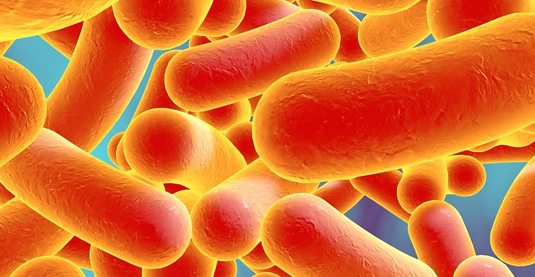Cell morphology shapes protein patterns

Precise control of thedistribution of specific proteins is essential for many biological processes. An LMU team has now described a new model for intracellular pattern formation. Here, the shape of the cell itself plays a major role.
The characteristic pattern of the zebra's stripes, the colorful banding seen on many seashells, and the spiral distribution of the seeds in sunflower heads are well-known instances of pattern formation in nature. Similar patterning processes take place at the cellular level. – In fact, they are a crucial component of many biological processes: For example, the location of the cleavage plane of a dividing cellis defined byspatially localized proteins. A group of researchers led by LMU biophysicistProfessor Erwin Frey has now used computersimulations to find out how such protein patterns can be created and maintained within the cytoplasm of bacterial cells.Their results point to a previously unsuspected mechanism, in which a stable protein pattern emerges under the direct influence of the spatial geometry of the cell alone. Their findings appear in the journal PNAS.
"We set out to simulate intracellular pattern formation in the bacterium E. coli," says Frey. When E. coli divides, the plane of division always lies precisely midway along the long axisof the rod-shaped cell. Genetic studies have shown that the proteins MinC, MinD and MinEserve as essential determinants of the site of the cleavage plane. These proteins constantly shuttle back and forth from one end of the cell to the other. This toing-and-froing movement is driven by a cyclical interaction between MinD and MinE. When MinD binds the nucleotide ATP, it attaches to cell membrane and recruits MinE. Formation of the MinDE complex in turn induces the slow hydrolysis of ATP to ADP. This leads to release of the two subunits into the cytoplasm, where MinD exchanges its bound ADP for another ATP molecule.This oscillatory behavior gives rise to a bipolar distribution, characterized by high concentrations of MinD and MinE at the ends of the cell and much lower levels in the middle. As a result, formation of the cleavage plane is inhibited at the poles, but not at the midpoint, of the growing cell.
Preferential accumulation at the poles
The model that Frey and his team members Dominic Thalmeier and Jacob Halatek developed to account for the formation of such a striking protein distribution was actually inspired by the effects of a related protein called AtMinD in this system. "The basis for this insight was provided by the experimental observation that the bipolar pattern still forms inE. coli mutants in which MinD and MinE had been replaced by AtMinD, a homologous protein expressed in the chloroplasts of the thale cress (Arabidopsis thaliana)," explains Thalmeier, first author of the study. Like MinD, AtMinD can exist in two nucleotide-bound forms. However, in this case, both can bind to the bacterial cell membrane.These two forms of AtMinD take over the role of MinD and MinE, oscillating between membrane-bound and soluble states under the control of a similar cycle of biochemical reactions.
"In our minimal model, the pattern-forming process is a consequence of the mass-action law, and is regulated by the fact that the two forms of AtMinD differ in their relative affinities for the cell membrane. But we also show that the geometry of the cell itselfplays a major role."The probability that a protein that is diffusing through the cytoplasm will make contact with the cell membrane depends on the area of membrane surface accessible to it. In the case of a rod-shaped cell, that probability is highest at both ends of the cell, due to the curvature at the poles. That is why the proteins preferentially bind to the polar membrane, and give rise to the bipolar pattern. This is confirmed by the fact that, when the simulations were performed in a spherical volume, the polarized pattern failed to appear. "In contrast to earlier theories, the new model does not require the proteins to be intrinsically sensitive to the degree of membrane curvature as such, and reaction rates do not need to be fine-tuned either," Frey explains. "In this respect, our model is fundamentally different from the famous Turing mechanism for pattern formation, and has the potentialto alter how we now view the whole issue of pattern formation in biological systems."
Frey and his colleagues now plan to search for other, similarly simple systems in other settings. If we can succeed in reconstructing such systems, one could combine different minimal patterning modules to mimic diverse important cellular functions. – In the long term, this could contribute to the development of an artificial cell, which would help us to gain a better understanding of complexbiological processes, concludes Frey.
More information: Dominik Thalmeier et al. Geometry-induced protein pattern formation, Proceedings of the National Academy of Sciences (2016). DOI: 10.1073/pnas.1515191113
Journal information: Proceedings of the National Academy of Sciences
Provided by Ludwig Maximilian University of Munich
















